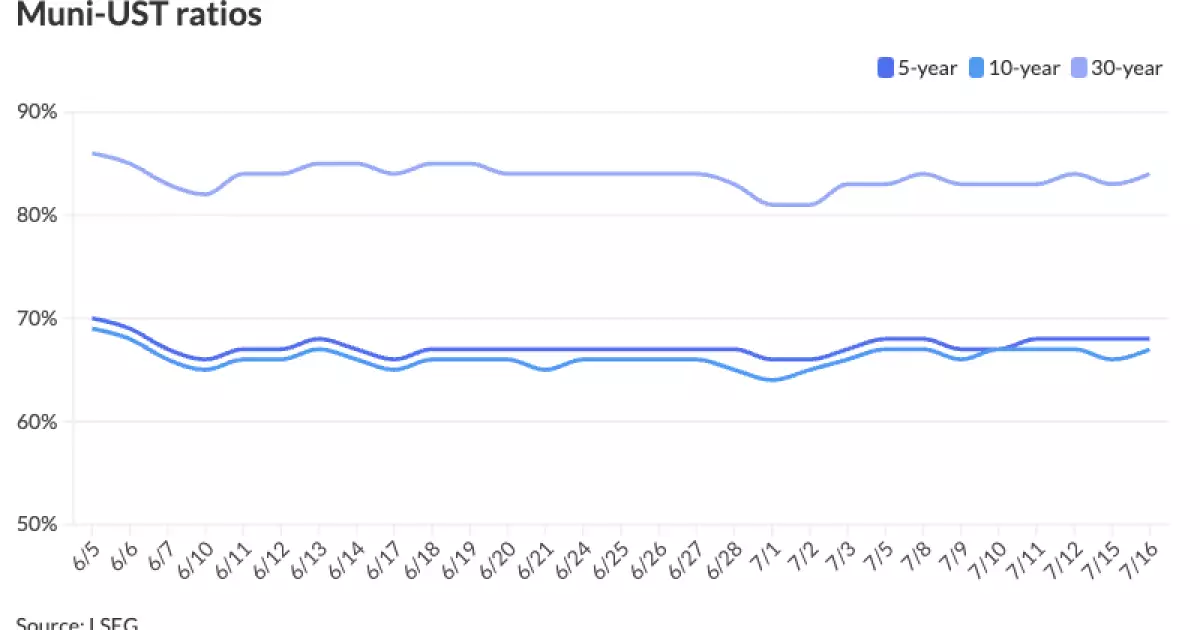In recent days, the municipal bond market has exhibited strong performance, particularly on Tuesday, as secondary trading showed noticeable firmness. A return of vigor to the primary market has accompanied this trend, presenting a landscape that is both inviting and complex for investors. U.S. Treasury yields have taken a downward turn, while the equity markets experienced gains, creating an environment ripe with opportunities for municipal bond investors.
The ratios comparing municipal bonds to Treasury yields indicate noteworthy shifts as well. For example, the two-year municipal-to-Treasury ratio settled at 65%, while longer maturities like the 30-year reached 84%. These figures reveal investor sentiment and potential strategic considerations driving decisions in the currently bullish atmosphere concerning municipal bonds.
The backdrop for this municipal market rally was significantly affected by June’s consumer price index report, which led analysts to surmise increased prospects for a Federal Reserve rate cut in September. This perspective was shared by Matt Fabian of Municipal Market Analytics, who pointed out that while the market showed strength, it did not advance sufficiently away from the front end of the curve. The short maturities currently seem “overbought,” warranting a more cautious buy recommendation. Conversely, the longer end of the curve has shifted into “very or exceptionally oversold,” presenting attractive total return opportunities for stylized investors willing to delve deeper into the market.
The considerable reinvestment expected in August, estimated at nearly $40 billion, represents a steadfast resurgence from the preceding month and highlights the underlying strength of investor interest in tax-exempt instruments. The increasing transactions, underscored by nearly 300,000 trades last week, reflect a solid inclination towards reallocating principal back into municipals, enhancing liquidity in the sector.
Recent trends point towards erratic mutual fund inflows, yet a rise in investment through exchange-traded funds indicates a shifting strategy among investors, with many adopting a wait-and-see approach in anticipation of more favorable market conditions for tax-exempt allocations. This method provides a means for flexibility—keeping capital liquid while re-evaluating the optimal timing for reinvestment.
Additionally, many dealers show increasing confidence by expanding their inventory balances. This approach is pivotal as it mitigates the impact of volatility in the primary market, allowing them to strategically unload inventory during periods of decreased issuance. Fabians observation that upcoming issuance levels are projected to remain robust through Q4 speaks to the optimism surrounding the municipal bond sector, despite present complexities.
Highlights of Recent Issuance
On a transactional level, the primary market showed actionable potential, with several notable price offerings prominently observed. For instance, Barclays priced a substantial $921.86 million aviation revenue refunding bond for Miami-Dade County, characterized by attractive yields on various maturities. Highlights included a 3.65% yield on five-year bonds maturing in 2027 and 3.90% on those maturing in 2036.
Further engaging the market’s interest, Bank of America Securities issued revenue anticipation certificates worth $248.105 million for the Northeast Georgia Health System. Their competitive yields, particularly at 3.27% for 2030 maturities, underline prevailing investor interest in viable options that offer security and sound returns.
Meanwhile, the Texas area continues to draw significant investment attention with various school district bonds slated for issuance. Such proactive measures in maintaining educational infrastructure reveal not only the local governments’ commitment to fostering growth but also the excellent prospects for yields in an investor-friendly environment.
Future Outlook and Strategic Considerations
Looking forward, the landscape of municipal bonds appears poised for sustained activity as evidenced by the diversity and volume of bonds to be priced this week. Projects involving essential public services from wastewater management to educational infrastructure serve as foundational pillars for community sustainability.
However, amid these positive indicators, a careful approach is warranted. As valuations in shorter maturities become increasingly inflated, discerning investors might focus on diverse strategies across longer maturities to maximize returns while managing risks effectively. Furthermore, macroeconomic variables and policy shifts remain crucial factors, as future Federal Reserve actions could substantially reshape market dynamics.
The municipal bond market’s current trajectory highlights a compelling narrative of growth, opportunity, and challenges that investors must navigate diligently. Balancing enthusiasm for emerging opportunities with a critical review of market conditions will be essential for successful investment strategies in the coming months. Understanding the intricate relationships between various maturities, policy shifts, and investor behaviors will guide savvy investors towards achieving their financial objectives in this dynamic market.


Leave a Reply